Electrical:
The installation of the electrical services, receptacles (outlets) and switches are often overlooked in the design of the accessible kitchen. Having easy access to receptacles and switches can make a kitchen truly accessible.
- Receptacles (Outlets)
- Wall outlets for countertop use - the normal location for a wall outlet; the wall above and behind the base cabinets in not an easily accessible location for someone in a wheelchair. Consider placing outlets on the face of the base cabinets or use flip-up countertop outlets, as shown in Figure 8.
- Wall outlets on cabinet vacant walls - wall outlets located away from cabinets should be at least 18 inches above the finished floor so that they are conveniently accessible for someone in a wheelchair or electric scooter.

Figure 8 - Flip up counter receptacle; open and closed
Note: Check with your local building department with respect to countertop mounted flip-up outlets. Many building departments will not approve their use even if they are UL and CSA approved.
- Switches
- Switches - install switches at a height of 48 inches from the top of the finished floor.
- Switch Style - Decorator style, rocker switches are easier to operate than toggle switches.
- Remote Control - Consider the use of remote control switches, as shown in Figure 9.
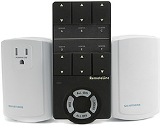
Figure 9 - Remote control switch
Additional information on remote control switches.
- Lighting
- Task lighting, which includes the lighting for food preparation, using the kitchen sink and the cooktop, should be mounted under cabinets or on ceilings to properly eliminate all work areas. It is important to check and correct the lighting installation for any countertop shadows that might appear when the kitchen is being used.
- Use under cabinet task lighting that does not emit a lot of heat, such as LED types, as shown in Figure 10.

Figure 10 - Under cabinet LED task lighting
- Additional information on under cabinet lighting and choosing light bulbs and lamps
- Make sure that all light switches, including the task lighting switches are located in an accessible location.
Appliances:
- Cooking
- A standard home range with burns on the top and an oven below should be replaced with a separate cooktop and oven.
- Cooktops
- the cooktop should be mounted in a base cabinet that provides underneath access for a wheelchair (knee space). The cooktop burner or element control knobs should be located in a position that does not require the user to reach across hot burners in order to adjust cooking temperatures, as shown in Figure 11.
- Additional information on cooktops
- Ovens
- the oven should be a built-in model, as shown in Figure 12, mounted in a base cabinet.
- Provide a heat-resistant pad of some sort close to the oven so that cookware that is removed from the oven can be conveniently set down.
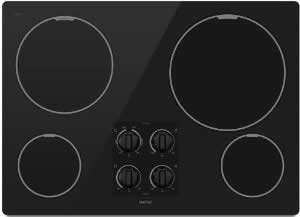
Figure 11 - Cooktop with front burner controls
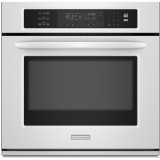
Figure 12 - Built-in oven
- Dishwasher
- Consider the use of a built-in drawer style dishwasher
, as shown in Figure 13, mounted in a base cabinet.
- Standard built-in front loading dishwashers
should be placed on a platform 9 inches high to allow for convenient loading and unloading, as shown in Figure 14.
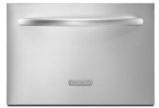
Figure 13 - Drawer style dishwasher
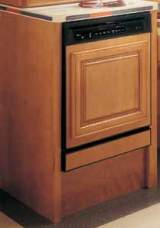
Figure 14 - Dishwasher raised 9 inches
- Microwave
- Microwave ovens
should be mounted in a base cabinet.
- Refrigerator/Freezer
- Side by side refrigerator/freezers
, as shown in Figure 15, are more convenient to access than a standard two door refrigerator/freezer with an upper freezer and lower refrigerator.
- Refrigerator/freezers that have the freezer as a drawer on the bottom
, and the refrigerator portion on the top of the appliance, as shown in Figure 16, are an acceptable alternative.

Figure 15 - Side by side refrigerator/freezer
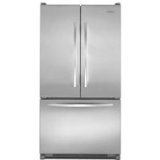
Figure 16 - Refrigerator with bottom drawer freezer
Turning Space:
A cramped kitchen can in itself a logistical nightmare. Wheelchairs require approximately 5 feet of turning space, 25 square feet in total. Placing objects such as island counters, chairs and stools within the kitchen area itself can make maneuvering difficult and hazardous.

